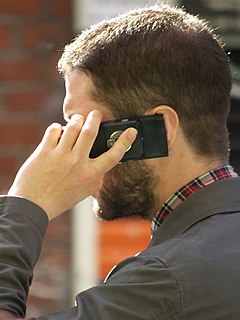This article includes a list of references, related reading or external links, but its sources remain unclear because it lacks inline citations .(October 2010) (Learn how and when to remove this template message) |
Prudent avoidance is a precautionary principle in risk management. It states that reasonable efforts to minimise potential risks should be taken when the actual magnitude of the risks is unknown. The principle was proposed by Prof. Granger Morgan of Carnegie Mellon University in 1989 in the context of electromagnetic radiation safety (in particular, fields produced by power lines).
The precautionary principle generally defines actions on issues considered to be uncertain, for instance applied in assessing risk management. The principle is used by policy makers to justify discretionary decisions in situations where there is the possibility of harm from making a certain decision when extensive scientific knowledge on the matter is lacking. The principle implies that there is a social responsibility to protect the public from exposure to harm, when scientific investigation has found a plausible risk. These protections can be relaxed only if further scientific findings emerge that provide sound evidence that no harm will result.

Risk management is the identification, evaluation, and prioritization of risks followed by coordinated and economical application of resources to minimize, monitor, and control the probability or impact of unfortunate events or to maximize the realization of opportunities.

In physics, electromagnetic radiation refers to the waves of the electromagnetic field, propagating (radiating) through space, carrying electromagnetic radiant energy. It includes radio waves, microwaves, infrared, (visible) light, ultraviolet, X-rays, and gamma rays.
A report for the Office of Technology Assessment of the US Congress described prudent avoidance of power line fields as:
- "...looking systematically for strategies which can keep people out of 60 Hz fields arising from all sources but only adopt those which look to be "prudent" investments given their cost and our current level of scientific understanding about possible risks."
The principle has been adopted in a number of countries, for example Sweden, Denmark, Norway, Australia and New Zealand. While not adopted by any regulatory body at the national level in the USA, the principle has been adopted in some form by a number of local regulatory bodies, for example the public utility commissions in California, Colorado, Connecticut and Hawaii. The Colorado Public Commission states:

Sweden, officially the Kingdom of Sweden, is a Scandinavian Nordic country in Northern Europe. It borders Norway to the west and north and Finland to the east, and is connected to Denmark in the southwest by a bridge-tunnel across the Öresund, a strait at the Swedish-Danish border. At 450,295 square kilometres (173,860 sq mi), Sweden is the largest country in Northern Europe, the third-largest country in the European Union and the fifth largest country in Europe by area. Sweden has a total population of 10.2 million of which 2.5 million have a foreign background. It has a low population density of 22 inhabitants per square kilometre (57/sq mi). The highest concentration is in the southern half of the country.

Denmark, officially the Kingdom of Denmark, is a Nordic country and the southernmost of the Scandinavian nations. Denmark lies southwest of Sweden and south of Norway, and is bordered to the south by Germany. The Kingdom of Denmark also comprises two autonomous constituent countries in the North Atlantic Ocean: the Faroe Islands and Greenland. Denmark proper consists of a peninsula, Jutland, and an archipelago of 443 named islands, with the largest being Zealand, Funen and the North Jutlandic Island. The islands are characterised by flat, arable land and sandy coasts, low elevation and a temperate climate. Denmark has a total area of 42,924 km2 (16,573 sq mi), land area of 42,394 km2 (16,368 sq mi), and the total area including Greenland and the Faroe Islands is 2,210,579 km2 (853,509 sq mi), and a population of 5.8 million.

Norway, officially the Kingdom of Norway, is a Nordic country in Northern Europe whose territory comprises the western and northernmost portion of the Scandinavian Peninsula; the remote island of Jan Mayen and the archipelago of Svalbard are also part of the Kingdom of Norway. The Antarctic Peter I Island and the sub-Antarctic Bouvet Island are dependent territories and thus not considered part of the kingdom. Norway also lays claim to a section of Antarctica known as Queen Maud Land.
- "The utility shall include the concept of prudent avoidance with respect to planning, siting, construction, and operation of transmission facilities. Prudent avoidance shall mean the striking of a reasonable balance between the potential health effects of exposure to magnetic fields and the cost of impacts of mitigation of such exposure, by taking steps to reduce the exposure at reasonable or modest cost. Such steps might include, but are not limited to 1) design alternatives considering the spatial arrangement of phasing of conductors; 2) routing lines to limit exposures to areas of concentrated population and group facilities such as schools and hospitals; 3) installing higher structures; 4) widening right of way corridors; and 5) burial of lines."
The prudent avoidance principle is seen as a better alternative than other proposed approaches to risk management, such as ALARA, because it makes reasonable efforts to reduce possible risk without creating a specific numeric standard that is not supported by strong scientific evidence.








